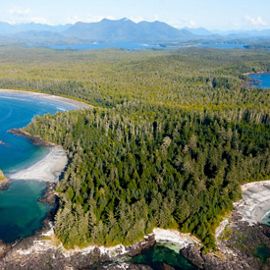We have the chance to protect old-growth forest while addressing climate change, habitat loss and social justice issues.
Clayoquot Sound is a stunning mosaic of emerald valleys, clustered islands and ancient trees along British Columbia’s southern coast. It is home to three First Nations: the Ahousaht, Tla-o-qui-aht and Hesquiaht, who have stewarded these lands and waters since time immemorial. In 2000, the area became British Columbia’s first UNESCO World Biosphere Reserve.
This area is also a critical piece of the Emerald Edge—a 100-million-acre coastal, temperate rainforest that stretches from coastal Washington, through British Columbia and into Southeast Alaska.
For the past 10 years, Nature United has worked in partnership with the Hesquiaht, Ahousaht, and Tla-o-qui-aht Nations in developing and advancing land-use visions that reflect their cultural, economic and environmental priorities.
These visions will ensure economic opportunities and protect natural resources like trees, fish, and clean water. We’re also working with the First Nations to establish a stewardship endowment that will fund First Nations-led management of natural resources for generations to come.
Our work in Canada is underpinned by a commitment to advancing Indigenous rights and authority. When Indigenous communities have the capacity and resources they need to manage the lands and waters in their territories, conservation results are effective, long-lasting, and supportive of social and economic well-being.
Clayoquot Sound teems with life. It is home to 297 different of species of flora and fauna that sustain people and ecosystems across the region.


Among them, black bears are an iconic sight, often glimpsed roaming the rocky shorelines. Whales and sea lions make their way through Clayoquot's waters, while bald eagles and osprey soar overhead.


The old-growth forests of Clayoquot Sound offer a critical haven for endangered and threatened species; the area hosts five Important Bird Areas and 35 Species-at-Risk-Act (SARA) sites. Four endemic species can be found in this region as well as several species of concern, such as the marbled murrelet.


We are working to protect one of the world’s last intact coastal temperate rainforest for the next generation while addressing climate and social justice issues that have eroded old-growth forests, wild salmon runs, and the economic well-being of communities.
In a key step forward, the government of BC committed in late 2020 to a change in land-use from commercial forestry to protection and sustainable management. Now all three levels of government—provincial, federal and Indigenous—are aligned toward a solution.
We are working alongside communities in Clayoquot Sound to:
Protect Old-Growth Forests
The most immediate need is to protect intact, coastal temperate rainforest in Clayoquot Sound. To acheive this goal, we support First Nations in implementing their Land Use Vsions.
Indigenous land is home to more species around the world than anywhere else, protecting 80% of global biodiversity.
We support sustainable economies by helping local partners create a more sustainable forestry model that benefits local communities, and also by working to diversify local revenue streams.
SUPPORT RESILIENT COMMUNITIES
When Indigenous communities have the capacity and resources they need to manage the lands and waters in their territories, conservation results are effective, long-lasting, and supportive of social and economic well-being.
Our shared vision is a sustainable region that is managed for and by its people. We are identifying models that increase Indigenous authority in decision-making, stewardship and economic diversification.
Following the lead of local partners, we are advancing Indigenous rights and authority through the design and financing of land protection that will secure a worldclass, Indigenous-led conservation area.
LEAD CLIMATE ACTION
As the Earth’s largest above-ground "pool" of carbon, forests play a critical role in regulating greenhouse gases in the atmosphere. How humans use forests impacts whether forests are sources (releasing carbon into the atmosphere) or sinks (absorbing carbon from the atmosphere). Because of this, forests can be a natural ally against rising emissions and slowing climate change.
And Clayoquot Sound, where an eco-system of old-growth forests contain what scientists consider "irreplacable carbon," we have a critical opportunity to harness the power of nature and fight climate change.
To fully demonstrate the benefit of nature-based solutions in tackling climate change, we are advancing a carbon-offset pilot in Clayoquot Sound.
By testing these concepts, we aim to create enduring funding solutions, such as carbon offsets and ecotourism models that support Indigenous partners in ensuring durable finance solutions for managing newly protected areas.
Support Our Work in Clayoquot Sound
Right now, we have a crucial window of opportunity to protect this global treasure and shape a new future for people and nature. We are partnering with local First Nations to create new protected areas of old-growth forest.

